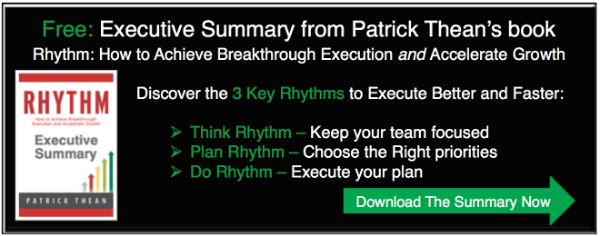Try optimizing, automating and outsourcing to reduce your stress and improve your performance.
I recently attended the Fortune Leadership Summit in Orlando, Florida. There were over seven hundred attendees made up of business owners, executive teams, business coaches, consultants, small to medium size businesses as well as a few very large corporations from around the world. The concept of the summit is to learn, and Verne Harnish, who coordinates the function, draws a parallel to Bill Gates’s “think week” in which he reads as many business books as possible in a week’s time to keep and get smart. In two days, we read the equivalent of eight business books.
As always, there were many great speakers, about which I will write in the next few weeks. One that really stood out and hit home with me was Ari Meisel. Ari was diagnosed with Crohn’s disease, which is an incurable disease of the digestive tract. After taking over a dozen medications daily and making no progress, he took things into his own hands and used yoga, nutrition, natural supplements and rigorous exercise to regain his strength and overcome the disease. He also began to look at all of the things he did in his life and began to find ways to eliminate or improve the efficiency of his activities. Through his experimentation and journey, he developed the “Art of Less Doing” which is based on nine fundamentals. The goal of this system of productivity is to make you more effective, healthier, and happier, while reducing stress along the way.
really stood out and hit home with me was Ari Meisel. Ari was diagnosed with Crohn’s disease, which is an incurable disease of the digestive tract. After taking over a dozen medications daily and making no progress, he took things into his own hands and used yoga, nutrition, natural supplements and rigorous exercise to regain his strength and overcome the disease. He also began to look at all of the things he did in his life and began to find ways to eliminate or improve the efficiency of his activities. Through his experimentation and journey, he developed the “Art of Less Doing” which is based on nine fundamentals. The goal of this system of productivity is to make you more effective, healthier, and happier, while reducing stress along the way.
Ari takes a three-prong approach to implementing his 9 fundamentals: optimize, automate and outsource everything you can. The idea is to first optimize what you do. There is no sense making something more efficient or automating it if you should not be doing it in the first place. The big takeaways for me are to simplify things, focus on the right activities/priorities, improve efficiency, and try to extend capabilities and efforts by outsourcing what you can. We use the term 10X a lot in our Rhythm coaching team and try to find ways to multiply our efforts tenfold by finding new and better ways to do things that scale our efforts.
Here is a brief overview of the nine fundamentals for your consideration.
Nine Fundamentals of the Art of Less Doing
1. 80/20 rule – The idea is to know where you are allocating your resources and spend time where you have the greatest potential impact. There are many tools you can use online to help you in this area. The idea is to first optimize and eliminate optional vs. essential activities and then look for ways to improve how efficiently you carry the activities out. Ari believes that 90% of what you do on a daily basis can be done by someone else or automatically.
2. Create an external brain - If you have an idea, get it out of your head and save it in a place that is backed up and accessible anywhere. Use tools like Evernote or GoogleDocs to store your thoughts and create a searchable database. Eliminate to do lists and only schedule things when you can get them done. Use many of the free services or low fee services that exist like FollowUp.cc or Fancy Hands to help you. The skill is to work on timing. Get the task in front of your face when you can do it.
3. Choose your own workweek - Create a time period when you are available to clients, vendors and coworkers. It does not mean that you are not working other times, but you control your schedule and availability. Use tools like ScheduleOnce to provide your availability to others and eliminate the back and forth emails of scheduling. Do not lock yourself into a nine to five workweek, and know when you are at your best to focus on the right activities. If you are most creative in the morning, this is the time to work on new innovative ideas. If the evening is the best time to write, spend time doing so after the children go to bed.
4. Customization – Customize the way you buy products that can make your life easier. Purchase vitamins from Vitamins on Demand and allow them to put your daily selection together to eliminate opening up multiple bottles each day. Use resources like Ponoko that offer 3D printing to customize things around you to better fit your needs. Indochino will custom-make and ship you a suit to meet your measurements.
5. Stop running errands - Use services like Amazon’s Subscribe and Save, Prime and ShopRunner to have items delivered to your doorstep. Try tools like TaskRabbit that uses other individuals to run errands for you. Try RedBeacon to find professionals to do those home chores you would like to relieve yourself of.
6. Organization – Set upper and lower limits on the things you own and how you organize your time. Get and stay organized and simplify what is around you. Eliminate the clutter and distractions. Get rid of obsolete items and limit what you buy. Use tools like DropBox and Chrome to gain access to your information wherever you are and on any device.
7. Finances – Apply the 80/20 rule to find out where your money is going. Automate as much as you can. Set up auto debit for monthly bills. Use services like OneReceipt to manage all of your receipts in the cloud. Use Mint.com or BillGuard to manage all of your personal finances and set goals or FileThis to manage all of your personal documents automatically. Analyze your spending to determine the best way to save and constantly be on the lookout for better deals.
8. Batching – Batch items that make more sense to do in bulk or at certain points in time. Deal with email last ten minutes of the hour or twice a day. Make lunch for the week on Sunday. Go paperless. Shoeboxed.com will scan your documents and store them for you digitally so they are searchable and saved forever. Do laundry in reasonable batches.
9. Wellness - Wellness is the foundation of everything - sleep, nutrition, fitness, supplements, and your ability to manage stress.
- You must get enough sleep and wake up at the right time of your sleep cycle. Use an activity tracker like FitBit, Argus or the Basis watch. Eliminate blue light the last hour of your day by buying a pair of blue blocker glasses and wearing them before bed. Keep your sleeping room at 68 degrees or lower.
- Spend time each week on fitness in three specific areas: strength training, yoga or some other core training exercise, and high intensive interval training. Crossfit Endurance is an excellent program to get you started.
- Take the appropriate supplements such as Vitamin D, probiotics and krill oil.
- Eat well for proper nutrition. We need more good fat in our diets. Our brain runs better on fat.
- Eliminate unnecessary stress. Take time to meditate daily or use the StressDoctor application to adjust your breathing and heart rate.
Ari admitted is that it is not easy to make these changes and implement everything. I shared the concept with my wife and she, like me, is very intrigued. We are going to work together to hold each other accountable. I walked away form Ari’s talk convinced that by implementing as many of these fundamentals as possible, I would reduce stress, improve my fitness, overall health and become more effective as I focus on the right things.
So, consider trying it. I challenge you to take the first step and begin looking at your daily life and optimizing the things you do. Ask yourself if the activities are optional or essential, and let the work begin.
Good luck and execute well, Alan
Photo Credit: iStock by Getty Images



 LinkedIn
LinkedIn
 Facebook
Facebook
